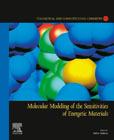
Molecular Modeling of the Sensitivities of Energetic Materials, Volume 21 is an authoritative guide to this exciting field of research, providing practical guidelines for implementing predictive models and their application to the search for new compounds. Beginning with an introduction to experimental aspects, the book then explores relationships between sensitivity, molecular structure and crystal structure, before going on to discuss insights from numerical simulations. The book then highlights applications of these approaches to the design of new materials. The strict safety requirements associated with experimental studies of energetic materials warrant a computer-aided approach for the investigation and design of safe and powerful explosives or propellants. Models must therefore be developed to allow evaluation of significant properties from the structure of constitutive molecules. Much recent effort has been put into modeling sensitivities, with most work focusing on impact sensitivity, leading to a lot of experimental data in this area. Modern machine learning techniques, new physics-based models, and new reactive molecular dynamics and multiscale simulation methods have subsequently led to quantitative procedures applicable to large datasets and yielded valuable insight into the underlying initiation mechanisms. Highlights a range of approaches for computational simulation and the importance of combining these in order to accurately understand or estimate different parameters Provides an overview of experimental findings and knowledge in a quick, accessible format Presents guidelines to implement sensitivity models using open-source Python-related software, supporting easy implementation of flexible models and allowing fast assessment of hypotheses INDICE: Part I. Experimental findings 1. Characterizing responses to insults from energetic materials 2. Relationships between sensitivities and other properties 3. Sensitivity and calorimetry measurements Part II. Data-driven approaches to sensitivity prediction 4. Correlations based only on molecular structure 5. Correlations involving quantum-chemical descriptors 6. Correlations involving a knowledge of crystal structure 7. Quantitative Structure-Property Relationships Part III. Theoretical descriptions of impact initiation 8. Statistical theory of impact initiation of explosives 9. From lattice vibrations to molecular dissociation 10. How electronic excitations could promote shock initiation 11. Thermal activation of the initiation and decomposition processes Part IV. Insight from numerical simulations of dynamical aspects 12. Quantum chemical investigations of reaction mechanisms 13. Molecular simulation of hot spot formation and reaction initiation 14. Buffers against external stimuli in crystals 15. Chemical kinetic modeling Part V. Applications to the design of new materials 16. Implementation of predictive models : practical aspects 17. End-to-end design of novel high energy density materials
- ISBN: 978-0-12-822971-2
- Editorial: Elsevier
- Encuadernacion: Rústica
- Páginas: 265
- Fecha Publicación: 01/06/2021
- Nº Volúmenes: 1
- Idioma: Inglés
